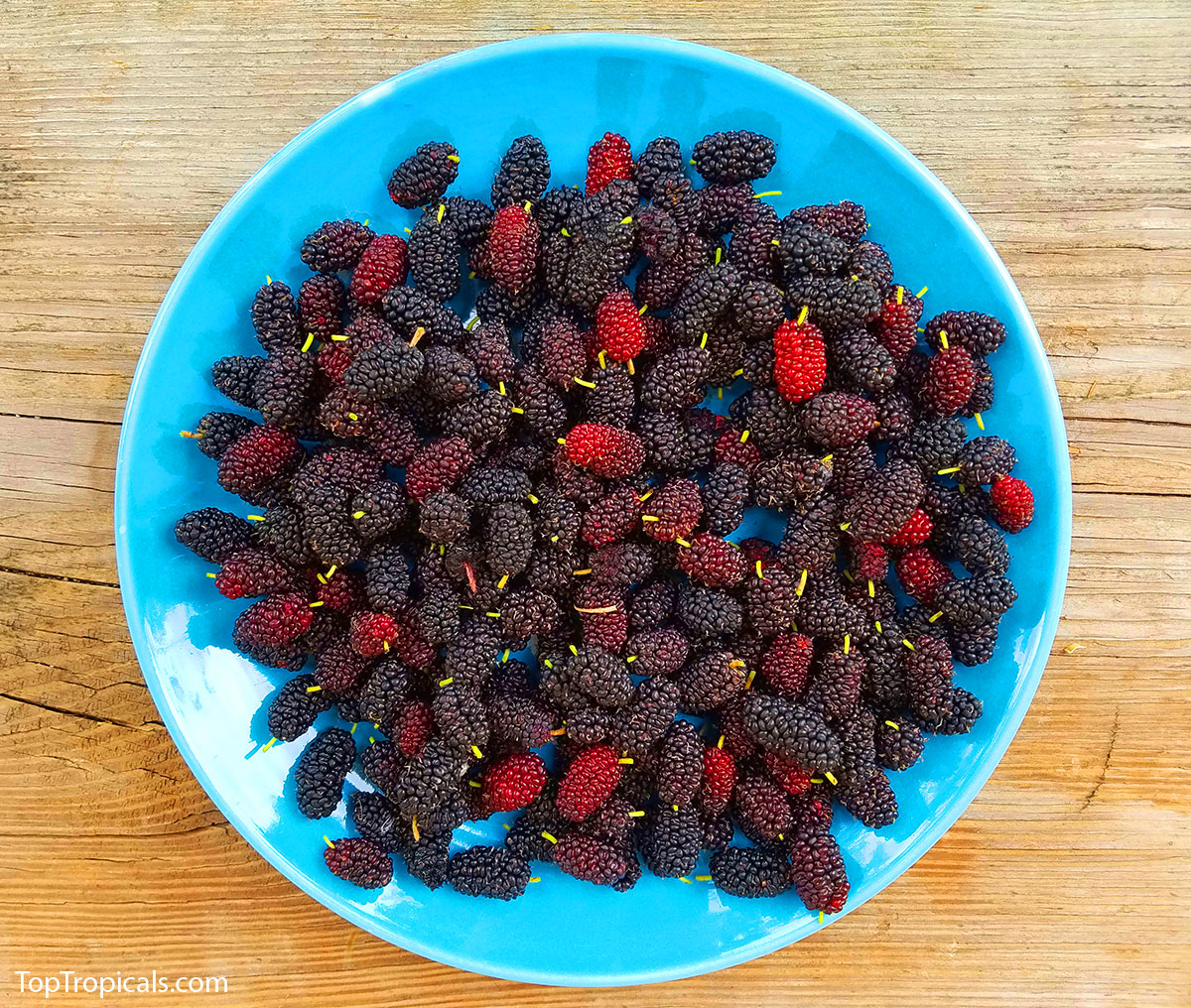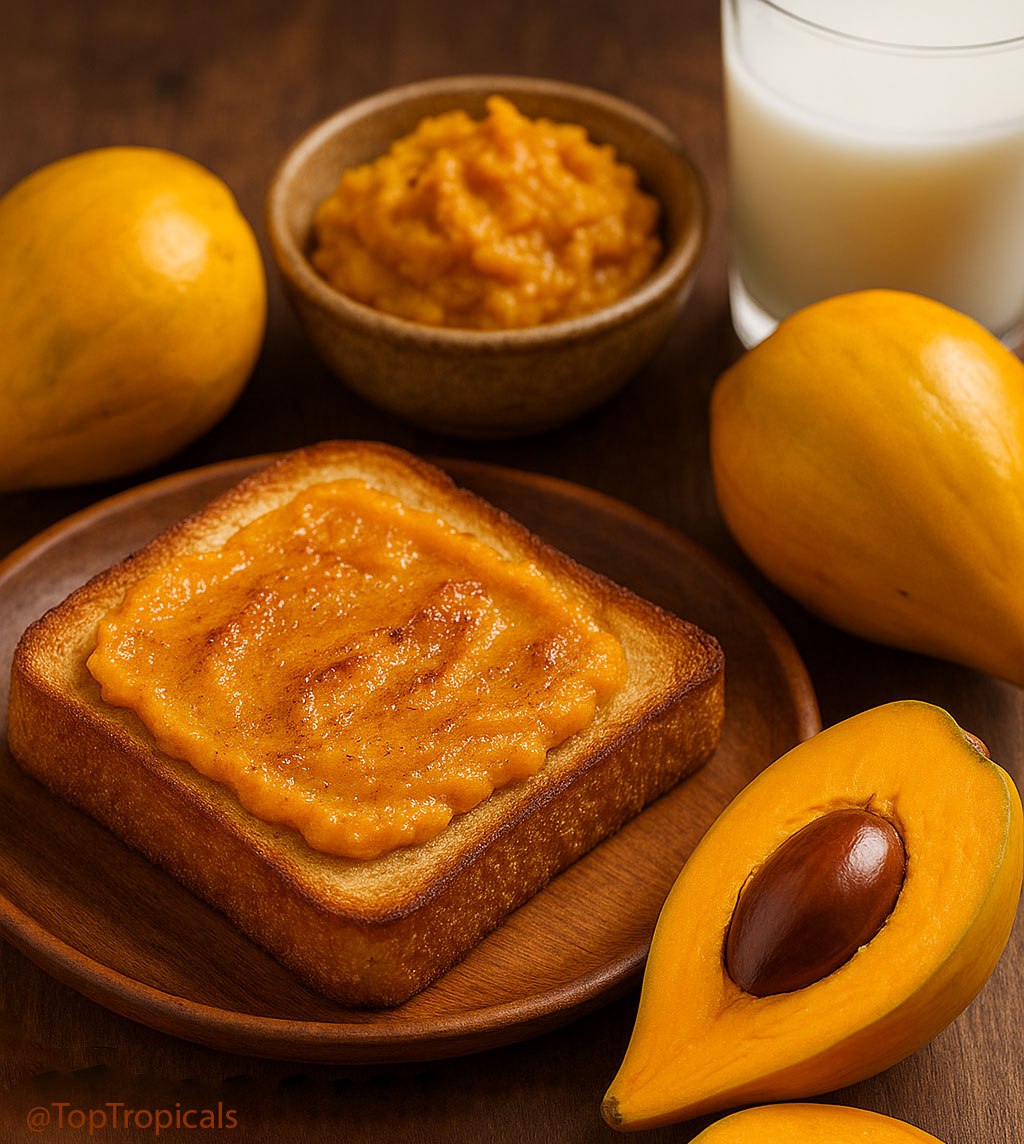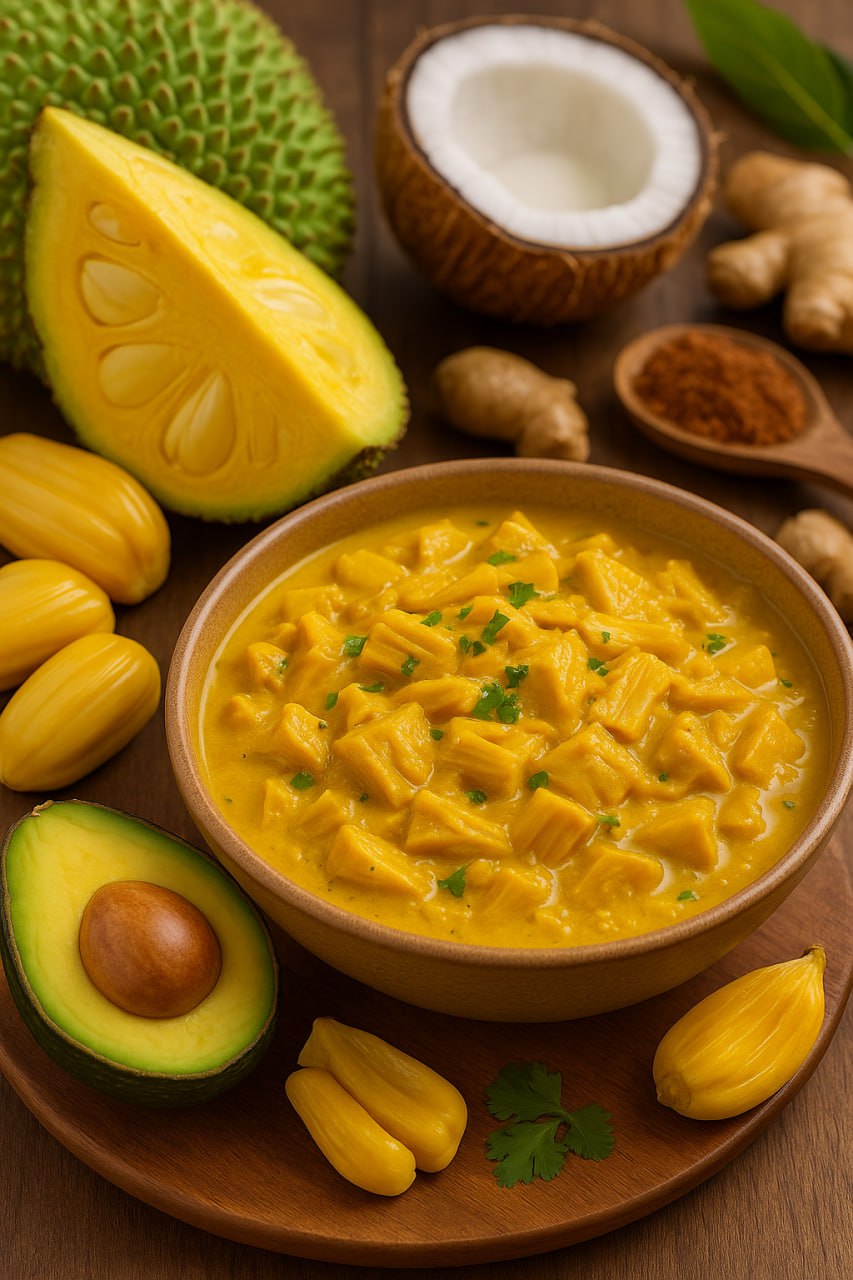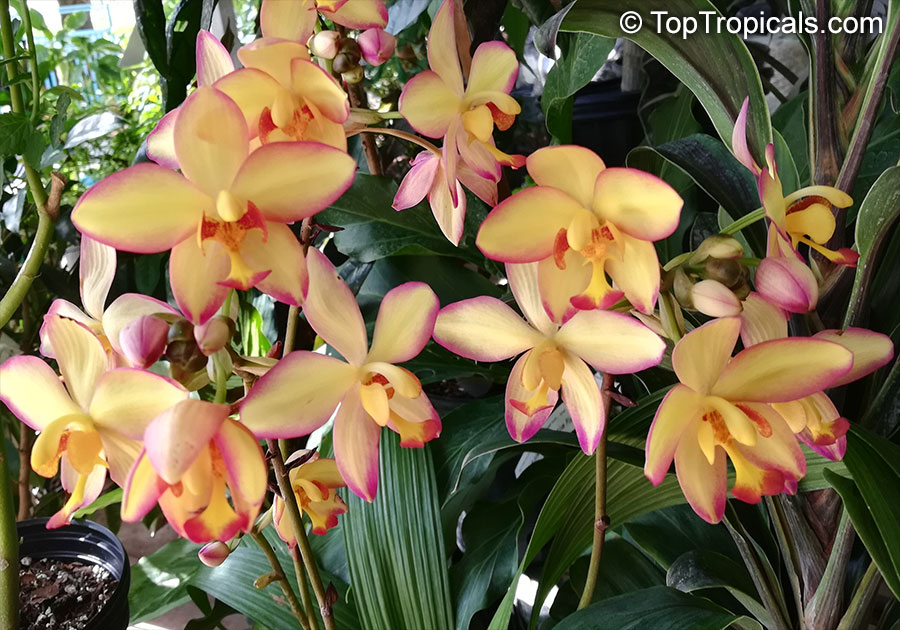Garden Blog - Top Tropicals
9 best tropical shrubs that bloom all summer long or year around
Abutilon darwinii x striatum - Fireball, Biltmore Ballgown, Acalypha hispida - Cat Tail, Chenille plant, Allamanda, Brunfelsia - Lady of the night, Calliandra - Powderpuff, Clerodendrum speciosissimum - Java Glorybower, Hibiscus El Capitolio, Rondeletia leucophylla - Panama Rose, Senna alata - Empress Candle, Candelabra Plant
- 🌺 1. Abutilon darwinii x striatum - Fireball, Biltmore Ballgown. Lantern-like blooms in orange, red, and yellow keep coming all summer. Compact and graceful, perfect for pots or borders.
- 🌺 2. Acalypha hispida - Cat Tail, Chenille plant. Fuzzy red tassels dangle nonstop in the heat, adding playful texture to containers and garden beds.
- 🌺 3. Allamanda (many varieties). Fast growers with trumpet flowers in yellow or pink. Can be shaped as shrubs, trellised vines, or flowering hedges.
- 🌺 4. Brunfelsia - Lady of the night. Creamy white blooms open at dusk, filling the evening garden with a sweet fragrance.
- 🌺 5. Calliandra - Powderpuff (many varieties). Cheerful pompom flowers in red, pink, or white attract hummingbirds and bloom nearly year-round.
- 🌺 6. Clerodendrum speciosissimum - Java Glorybower. Bright red flower clusters stand out against tropical foliage. Loves sun and steady moisture.
- 🌺 7. Hibiscus El Capitolio - Unique, double-skirted, ruffled pendant blooms with pom-pom-like centers make this hibiscus a showpiece shrub for summer gardens.
- 🌺 8. Rondeletia leucophylla - Panama Rose. Compact and butterfly-friendly, with fragrant pink flower clusters that perfume warm evenings.
- 🌺 9. Senna alata - Empress Candle, Candelabra Plant. Bold, upright candles of golden flowers shine through the season and draw in pollinators.
🛒 Explore most spectacular flowering shrubs
#Hedges_with_benefits #Discover
🟢 Join 👉 TopTropicals
Date:
 Mulberry Care and Growing Tips
Mulberry Care and Growing Tips
Mulberries are tough, low-maintenance fruit trees that adapt to many conditions.
- Climate: Hardy from USDA zone 5 to 10.
- Soil: Grow well in almost any soil; prefer good drainage.
- Watering: Regular watering during dry spells; drought tolerant once etablished.
- Growth: 3–5 feet per year, producing fruit early.
- Pruning: Annual pruning controls size and improves branching.
- Pot culture: Dwarf types thrive in containers, staying 6–7 feet tall. Use a large pot, water consistently, and prune lightly. Use Abundance potting mix for best results.
- Fertilizer: For reliable production, fertilizer regularly. Apply Sunshine C-Cibus liquid booster with every watering, or Green Magic controlled release fertilizer every 5-6 months.
❓ Mulberry FAQ
How soon will a mulberry fruit?
One to two years, sometimes the very first season.
What climates are suitable?
USDA zones 5–10, from -20F winters to hot summers.
How tall do they get?
Standard trees 20–30 ft; dwarfs 6–10 ft in pots.
Do I need more than one tree?
No, they are self-pollinating.
What do they taste like?
Sweet and juicy, like a blend of blackberry and raspberry.
How long is the harvest?
Everbearing types ripen gradually from summer into fall.
Do birds eat them?
Yes, but trees are so productive there’s plenty to share.
Are they messy?
Dark-fruited varieties can stain; white mulberries do not.
Can I grow them in containers?
Yes, dwarf types (Dwarf Everbearing, Issai) fruit well in pots.
How long do they live?
Many live for decades; Illinois Everbearing can endure for generations.
What are the health benefits?
Mulberries are low-glycemic, support healthy blood sugar, improve heart health, and are rich in antioxidants.
Date:
🍇Mulberries – the hidden gems of every garden
Picture this: it’s July, the sun is warm, and you step outside to a tree dripping with berries. You reach up, and your fingers come away stained purple. The taste? Like blackberries kissed with raspberry — sweet, juicy, unforgettable.
That’s what a Mulberry gives you. And the best part? You don’t wait years. Many trees fruit the very next season. Dwarf types can even fruit nearly year-round in pots — fresh berries on your patio, without leaving home.
🌟 Varieties gardeners swear by:
In the photo above: mulberry varieties - Illinois Everbearing, Dwarf Everbearing, Shangri-LA, White Mulberry, Pakistani Giant, Issai, Florida Giant
- Illinois Everbearing – legendary flavor, harvests all summer.
- Dwarf Everbearing & Issai – perfect for patios, nonstop fruit.
- Florida Giant – big tree, big berries, big flavor.
- Shangri-La – thrives in heat, huge leaves, steady crops.
- Pakistani Giant – 2-3" long fruit, very juicy.
- Tise – sweet, large flavorful fruit, early season.
- White Mulberry – sweet and clean, no stains.
Mulberries aren’t just delicious — they’re loaded with antioxidants, help balance blood sugar, and make your garden come alive with birds and shade. Don’t wait another season. Plant your Mulberry now and taste the difference by next summer.
Watch short videos:
💲 Special Offer – 20% off Mulberry Trees!
Get 20% OFF already discounted Mulberry Trees with code
MULBERRY2025
Min order $100. Excluding S/H, valid online only, cannot be combined with other offers.
Hurry, offer expires September 23, 2025!
You wont believe what this cat is eating for lunch!
Cat Niki
"When life gives you lemons, throw them back and ask for a banana!"
🐈📸 Cat Niki is eating dry bananas at TopTropicals PeopleCats.Garden
#PeopleCats #Quotes
🟢 Join 👉 TopTropicals
Canistel custard toast: Quick-n-Fun exotic recipes
- 🟡Mash Canistel (Eggfruit) with a bit of cream and cinnamon, spread on toast, and broil until golden.
- 🟡Like dessert for breakfast!
Canistel Custard Toast: Exotic Recipes
Ingredients
- 1 ripe Canistel (Eggfruit), mashed
- 2 tbsp cream
- 1/4 tsp ground cinnamon
- 2 slices of bread
Instructions
- Preheat broiler.
- Mash Canistel with cream and cinnamon until smooth.
- Spread mixture on bread slices.
- Broil until golden and slightly caramelized.
- Serve warm, like dessert for breakfast.
🛒 Plant your own Canistel tree
#Food_Forest #Recipes
🟢 Join 👉 TopTropicals
Baby bird first flight caught on video - ending left us stunned!
Baby bird first flight
Greenhouse nest story - surprise ending you have to see!
❓ Does anyone know the name of this Florida bird? 🐦⬛️
#PeopleCats
🟢 Join 👉 TopTropicals
Free natural shampoo: squeeze it and see what comes out!
Pine Cone Ginger - Zingiber Zerumbet, Shampoo Ginger
- 💄Pine Cone Ginger (Zingiber Zerumbet), is called Shampoo Ginger due to its unique, milky substance found in the cones. If you squeeze these bright red cones, a fragrant, milky liquid seeps out - traditionally used in Asia and Hawaii as a natural shampoo. Even today, you’ll find it in commercial shampoos.
- 💄 But there's more to it than hair care. All parts of the plant carry a spicy fragrance, the cones make striking, long-lasting cut flowers, and the whole plant adds a tropical vibe to your garden.
- 💄 And here's a fun history twist: Pine Cone Ginger is a "canoe plant", carried across the Pacific by ancient Polynesian voyagers. Imagine - this little shampoo factory traveled the ocean in canoes centuries ago!
Would you try washing your hair with this tropical ginger?
🛒 Grow your own Natural Shampoo Ginger
📚 Learn more:
#Shade_Garden #Container_Garden #Remedies #Food_Forest
🟢 Join 👉 TopTropicals
What kind of animal do you think it is?
Pelmen - hairless Sphynx cat
A fox?
A dog?
An Alien?
🐈📸
He does look like an alien!
#PeopleCats
🟢 Join 👉 TopTropicals
What is Akee - Jamaicas National Fruit - and how to grow it
🛒 Plant your own Akee (Achee) tree
📱
#Food_Forest
🟢 Join 👉 TopTropicals
Banned Jamaican fruit: why you never see fresh Akee in U.S. stores?
Akee (Blighia sapida)
Did you know that fresh Akee (Blighia sapida) is restricted for import into the U.S.?
That's the bad news.
The good news: you can grow your own Akee tree and enjoy this famous fruit right in your backyard!
The reason it's restricted is because unripe Akee (Ackee) contains toxins. Only when the pods split open naturally is the fruit safe to eat, after cooking (video). That’s why it's hard to import fresh – but easy to grow and handle at home once you know the trick.
Plenty of people love this fruit (it's actually a vegetable). It's the national fruit of Jamaica, and a must-have in the classic dish Akee and saltfish. Planting your own tree means you never have to miss out.
⛔️ Why grow Akee?
- ✔️Fresh fruit that you simply can’t buy in U.S. stores.
- ✔️You decide when it's ripe and safe, straight from the pod.
- ✔️A taste of Jamaica in your own garden - both food and culture in one tree.
So don't wait for the fruit that never arrives at the port. Plant your own Akee tree and enjoy the harvest tomorrow!
🛒 Plant your own Akee (Achee) tree
📚 Learn more:
▫️New Christmas ornaments? Ackee monster fruit!
📱 How to cook perfect Akee
#Food_Forest
🟢 Join 👉 TopTropicals
Jackfruit curry quickie: Quick-n-Fun exotic recipes
🟡Saute young Jackfruit chunks with coconut milk, curry paste, and ginger.- 🟡Tastes like pulled chicken curry, but totally plant-based!
🍲 Jackfruit curry exotic recipes
Ingredients
- 2 cups young Jackfruit chunks
- 1 cup coconut milk
- 2 tbsp curry paste
- 1 tsp fresh ginger, grated
Instructions
- Saute young Jackfruit chunks with curry paste and ginger.
- Add coconut milk and simmer until the Jackfruit is tender.
- Serve hot. Tastes like pulled chicken curry, but completely plant-based!
🛒 Shop Jackfruit varieties
#Food_Forest #Recipes
🟢 Join 👉 TopTropicals
Which dog would you take home: golden, black or chocolate?
Sunshine (golden), Draco(chocolate) and Lila (black) Labrador dogs
"Dogs come when they're called; cats take a message and get back to you later." - Mary Bly
🐈📸 Sunshine (golden), Draco(chocolate) and Lila (black) Labrador dogs at Top Tropicals Bfarm and PeopleCats.Garden.
#PeopleCats
🟢 Join 👉 TopTropicals
Watch this before cooking with black pepper!
Black pepper (Piper nigrum)
Black pepper (Piper nigrum) is famous for its berries, but the leaves are edible too, and in some regions they’re used just like betel leaves or bay leaves. Here are a few ways you can use them:
- Cooking wrap: Fresh leaves can be used to wrap fish, meat, or rice before steaming or grilling, similar to banana or betel leaves. They add a mild peppery aroma.
- Flavoring curries and soups: Whole leaves can be simmered in curries, broths, or stews to infuse a gentle peppery note, then removed before serving (like bay leaves).
- Herbal teas: Fresh or dried leaves can be steeped with ginger, turmeric, or lemongrass to make a warming tea traditionally used for digestion and colds.
- Chutneys and pastes: In South India, young pepper leaves are ground with coconut, tamarind, and chilies to make a tangy chutney.
- Medicinal uses: Folk remedies use the leaves for coughs, sore throats, and as a poultice for muscle aches.
🍛 Black pepper leaf chutney
- ♨️Lightly saute 6-8 pepper leaves in a little oil.
- ♨️Blend with 1/2 cup grated coconut, 2 green chilies, tamarind, salt, and cumin.
- ♨️Optional: top with a quick tempering of mustard seeds and curry leaves.
- ♨️Serve with rice or dosa.
☕️ Pepper leaf tea - when you feel under the weather
- Boil 2-3 leaves with a cup of water.
- Add a slice of ginger and a pinch of turmeric (optional).
- Simmer 5 minutes, strain, and sweeten with honey.
Both recipes give a warm, peppery aroma without being too spicy. Pepper leaves are milder than the berries, so you’ll get aroma more than heat.
🛒 Grow your own Black Pepper plant - spice and vegetable!
📚 Learn more:
- ▫️ What is Pepper Made From? Black, white, green, and red...
- ▫️How to grow your own Pepper plants. Five most valuable 'Pipers'
#Food_Forest #Recipes
🟢 Join 👉 TopTropicals
Date:
 Ground Orchid FAQ – Your Questions
Answered
Ground Orchid FAQ – Your Questions
Answered
Why should I buy them?
Because they give you more bloom for less effort. They flower on and off almost all year, they’re tough, and they come in colors you can actually plan a garden around.
Will they survive winter in my area?
In frost-free zones, yes, they come back bigger every year. If you’re farther north, just keep them in pots and bring them inside for the cold months.
Do they really bloom in shade?
They do. We’ve got a clump under a big oak and it still puts on a show. Not as heavy as full sun, but enough to brighten the spot.
How big do they get?
Depends which one. Spathoglottis stays neat, about knee-high. Nun Orchid shoots up tall spikes that can hit 4 ft. So you can go small or dramatic.
Are they hard to care for like other orchids?
Not at all. Forget the bark mix and misting bottles. Just plant them in soil, keep the water steady, and feed once in a while. That’s it.
Can I grow them in pots?
Absolutely. They do great in containers. Makes it easy if you’ve only got a patio or you want to move them in for winter. Use well-drained soilless mix like Abundance Potting Mix.
Do they attract pollinators?
Yep. Bees love them, butterflies too, and every so often a hummingbird will check them out.
What is the best fertilizer?
For extra blooms, we use Sunshine Orchidasm – Orchid TotalFeed Booster. Works like a charm!
Date:
🌸 Meet the Most Colorful Ground Orchids
Ground Orchids – Spathoglottis, Phaius, Arundina, Epidendrum
- Chinese Nun Ground Orchid (Phaius tankervilleae)
- Yokohama Ground orchid Kate (Bletilla striata x formosana)
- Tropical Punch, Sorbet Ground Orchid (Spathoglottis plicata)
- Bamboo Orchid (Arundina graminifolia)
- Snow Angel, Coconut Cloud Ground Orchid (Spathoglottis alba)
- Orange Reed Ground Orchid (Epidendrum radicans Sunrise)
- Lemon Kiss, Sorbet Ground Orchid (Spathoglottis chrysanta)
- Pink Reed Ground Orchid, Violet Queen (Epidendrum radicans Fuchsia)
- Lavender Reed Ground Orchid (Epidendrum elongatum x radicans)
- Red Raspberry Reed Ground Orchid (Epidendrum radicans Red Glow)
Orchids have a mystique that sets them apart — elegant, exotic, almost unreal in their perfection. But let’s be honest, not everyone has luck with the fancy ones that cling to trees or need greenhouse tricks.
Ground orchids are different. They grow in regular garden soil, bloom in sun or shade, and come in all sorts of shapes and colors. They’re the orchids you don’t have to fuss over.
Nun Orchid (Phaius tankervilleae) – Ever wonder why it’s called the Nun Orchid? The flowers really do look like the white veil and brown habit nuns used to wear. The plants send up spikes 3–4 ft tall with 10–20 fragrant blooms that open one after another for weeks. I like them best tucked under trees where they just keep spreading year after year.
Spathoglottis – The nonstop bloomer – If you want flowers that just don’t quit, this one’s it. Spathoglottis clumps up and throws spikes of purple, pink, or yellow that last for weeks, then keep coming back through the summer. In warm spots they’ll bloom almost year-round. Honestly, it’s one of the easiest orchids you’ll ever grow.
💲 Special Offer – 20% off Ground Orchids!
Get 20% OFF ground orchids with code
ORCHID2025
Min order $100. Excluding S/H, valid online only, cannot be combined with other offers.
Hurry, offer expires September 17, 2025!






